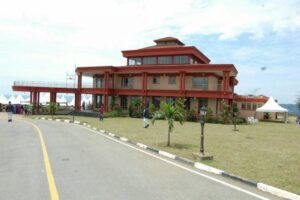BUSOGA KINGDOM (OBWAKYABAZINGA BWA BUSOGA)

The Busoga Kingdom, one of the four main constitutional monarchies in present-day Uganda, was established in 1862 as a cultural institution in the eastern part of the country. According to Article 246 of the Constitution of the Republic of Uganda, cultural institutions like Busoga Kingdom play essential roles in nation-building by:
- Promoting and preserving cultural values, norms, and practices that enhance the dignity and well-being of the people within the Kingdom.
- Encouraging the development, preservation, and enrichment of all individuals in the Kingdom.
Busoga” means “Land of the Soga” and refers to the kingdom of the 11 principalities of the Basoga or Soga (singular Musoga) people. The Kingdom’s headquarters are at Bugembe Sub-County in Igenge, Jinja City, Uganda’s second-largest city after Kampala.
In 1993, cultural institutions were reinstated by the National Resistance Movement (NRM) Party Government led by President Yoweri Kaguta Museveni after being abolished by former President Dr Milton Obote in 1966. Cultural institutions like Busoga Kingdom are centrally supervised under the Ministry of Gender, Labour, and Social Development. The Busoga Kingdom, situated in the “Busoga Region” of eastern Uganda, maintains a non-partisan, ceremonial relationship with the political leadership of Busoga.
Alongside the kingdom’s establishment are 12 Local Government administrative centres governed under the Ministry of Local Government. These Local Governments are political and administrative units with legislative and executive powers, federated under the Busoga Consortium for Development (BCD)/Province. The BCD is headed by a Governor elected from among the 12 Local Government Leaders of Busoga. The current Governor of the BCD is Honorable Wakaze Simon, who also serves as the Local Government Chairperson of Luuka District.
The Kyabazinga, the cultural leader of Busoga, has significant influence and commands great respect from political leaders and the entire population. This influence enables him to drive social change and community transformation effectively.
LEADERSHIP
The Busoga Kingdom is led by the traditional cultural leader, the “Isebantu Kyabazinga.” The current Kyabazinga of Busoga Kingdom is His Royal Highness William Kadhumbula Gabula Nadiope IV, from Bugabula Chiefdom. He is the grandson of Wilberforce Kadhumbula Nadiope, former Vice President of Uganda and a Kyabazinga of Busoga Kingdom. The Kyabazinga is not succeeded by his children but is elected by the 11 Chiefs from the 11 Chiefdoms that form the Kingdom.
The Kyabazinga’s wife is “Inhebantu,” meaning “mother of all people.” Her Royal Highness, Joviah Mutesi, currently holds this position. The Kyabazinga appoints a Prime Minister and two Deputy Prime Ministers to assist in governance. The current Prime Minister is Owek. Dr. Muvawala Nsekere Joseph also serves as the Executive Director of the National Planning Authority of Uganda. The Prime Minister is supported by Owek. Prof. Dr. Lubega Muhammed is the 1st Deputy Prime Minister and Owek. Osman Noor Ahmed as the 2nd Deputy Prime Minister.
The Kingdom has a Parliament, known as the “Lukiko,” headed by a Speaker, and a Royal Council called the “Busoga Royal Council,” which includes the 11 traditional chiefs of Busoga.
CHIEFDOMS
Until the 19th century, Busoga was divided into independently ruled chiefdoms. Five sons of the Kabalega migrated into Busoga from Bunyoro Kingdom, located in western Uganda. These sons became chiefs and assumed the following titles.
- Zibondo of Bulamogi Chiefdom
- Gabula of Bugabula Chiefdom
- Ngobi of Kigulu Chiefdom
- Tabingwa of Luuka Chiefdom
- Nkono of Bukono Chiefdom
The other tribal chiefs are.
- Wakooli of Bukooli
- Ntembe of Butembe
- Menha of Bugweri
- Kisiki of Busiki
- Luba of Bunha
- Nanhumba of Bunhole
These chiefdoms federated to establish the Busoga Kingdom in 1906.
For more details on Busoga Kingdom, please visit the Kingdom’s website: [www.busogakingdom.com] (http://www.busogakingdom.com)

